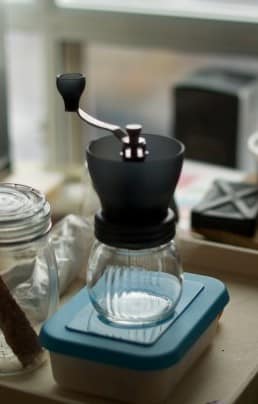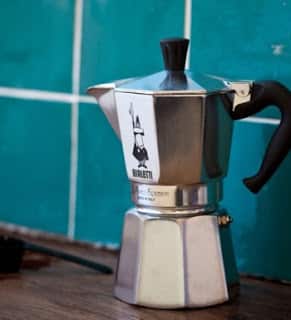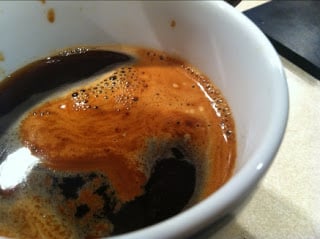 I’ve always been a big fan of coffee over espresso because of difference in the volume of liquid between the two. A double-shot of espresso for instance is only 3.5-4oz compared to my standard 6-cup brew of coffee I tend to make every morning.
I’ve always been a big fan of coffee over espresso because of difference in the volume of liquid between the two. A double-shot of espresso for instance is only 3.5-4oz compared to my standard 6-cup brew of coffee I tend to make every morning.
What I’ve found to be a great middle ground between the two is the common Americano (pictured left) which is espresso mixed with hot water. Sure you could call it watered down espresso but I prefer to call it fancy coffee because it rivals the volume I’d get out of my coffee maker but the drink itself is just better.
My wife in fact has come to a point where she won’t drink coffee at all. If she’s not drinking Earl Grey she’s drinking an Americano. It’s espresso or nothing for her.
This all got me inspired to find an economical way of making good espresso from home so that we both could enjoy a cup together and this is what I came across.
How I Make Espresso Without An Espresso Machine
The best way to get espresso at home is to use freshly roasted beans from a local company. People that I trust have convinced me that local (small) roasters tend to be the best places to get freshly roasted beans.
Then, the exact time you are ready to make your espresso you grind your beans. You don’t do it at the market or days in advance, you do it on the spot with a conical burr grinder. This ensures the best flavor possible.
Yeah, you can easily overspend on burr coffee grinders but I like simple products and they tend to be the cheapest. A simple hand crank grinder like this one is awesome if you have the patience to use it.
Using a slightly coarser grind than espresso grind you then put your ground beans into one of these super affordable stovetop espresso pots (small, medium, large) and bring it to a boil slowly. Let the boiling action of the water work it’s magic. The steam forms the pressure needed to make good espresso.
It’s amazing that this contraption is so simple and cheap yet people readily spend hundreds for a fancy machine that’s typically far more complicated to use, keep clean, or service. The stovetop unit wont froth milk but for straight espresso, americano’s and some after-dinner coffee drinks all you need is the classic stovetop pot shown above.
You can see more top rated stovetop espresso pots in the store.
What’s great about making your espresso this way is that you have full control over the water, grind, beans, and ratio of espresso to hot water that is used. No longer do you have to settle for a 4:1 ratio at a coffee bar using regular tap water. You can bust out your bottled water and take whatever steps you need to to make the best cup possible for your own tastes.
=====
How To Make Espresso At Home Without A Fancy Machine
How do I love coffee?
Let me count the ways.
For sure, there’s the usual brewed coffee to perk up my daily mornings and get me ready for the grind. I also love latte and cappuccino. I enjoy these drinks when catching up with friends.
But when I tried espresso, it was pure love. At first, I thought it would be too bitter for my liking.
I was pleasantly surprised.
Espresso is pure, unadulterated coffee love. No wonder many coffee aficionados invest on a good espresso machine so they could have espresso at home, anytime they want it.
For some coffee lovers, getting an espresso machine may not always be an option. What to do now?
Fortunately, there are smart ways and ingenious methods to make espresso at home without a fancy espresso machine. How? Let’s find out.
What is an espresso coffee?
Many people think that espresso is black coffee. It’s easy to understand why there is a common misunderstanding. Espresso is coffee, yes. But not every black coffee is espresso.
Espresso is made from forcing very small amount of pressurized hot water into fine ground espresso beans. This process creates a thick crema that sits on top of an espresso shot. Often, specialized espresso machines are needed to introduce that kind of pressure.
“Espresso machines work by forcing extremely hot water through finely ground coffee at enormous pressure—ideally, nine times atmospheric pressure, or nine bars. That’s about 130 pounds of pressure per square inch, or roughly twice the pressure in your average truck tire.”
While pressure is an important element in making espresso, there are two other factors needed to yield a good espresso – roast and grind.
Coffee roasters know that roasting coffee can create variations in the final coffee product. This is especially true for espresso. Making espresso requires a special kind of beans. Often, roasters make an espresso roast. This is a darker roast that yields a stronger and bolder coffee flavor. The taste and aroma is distinctive from regular drip or brewed coffee. If you plan to make espresso at home, be sure to buy an espresso roast and grind beans on demand so you can get fresh tasting espresso at home.
Making a cup of espresso requires a special kind of grind. Unlike regular brew that needs coarse ground coffee, espresso needs find ground coffee. Fine ground coffee slows down water penetration; thus, pressure is needed to extract the espresso kind of coffee.
3 Ways to make espresso at home without a fancy machine
Again, it’s impossible to make authentic espresso without an espresso machine because pressure plays a key role in extracting a great tasting espresso shot. However, you can make an alternative espresso coffee at home. Check these methods.
Aeropress
Using an Aeropress can be the cheapest and most acceptable espresso alternative. An Aeropress requires manual pressure. Through this, you can probably achieve about a pressure gauge of 3 bars. This seems good enough, since an espresso machine creates 9 bar pressure. At least, you have one third of the required pressure to extract espresso.
In addition to the use of pressure, you can control temperature and brew fine ground espresso beans. This avoids burning your beans.
How to make espresso using an Aeropress:
- Heat up water up to 180 degrees Fahrenheit.
- Prepare 17 grams of coffee.
- Grind the coffee, aim for a semi-fine ground coffee.
- Clean a paper filter and place it inside the Aeropress.
- Add 50 grams of hot water, for steeping.
- Let it steep for 30 seconds. Stir to steep the grounds evenly.
- Add the remaining water slowly.
- Press the plunger very slowly.
- Pour the coffee in cups.
Moka pots
Moka pots remind us of traditional coffee brewing methods. One of the challenges with using a moka pot for espresso is water temperature. Moka pots need high temperature to create pressure. When water is at the boiling stage, it creates a nice pressure that can be used for espresso alternatives. However, that same amount of heat can burn coffee and cause over-extraction. This is very far from our beloved espresso.
How to make espresso using moka pot:
- Fill moka pot with hot water.
- Grind coffee beans that is finer than drip coffee.
- Fill the coffee filter loosely. Do not pack the grounds.
- Make sure that the rim is clean to lock in the pressure when the water starts boiling.
- Place under medium heat, using a gas stove.
- Wait for the water to start flowing in the top reservoir.
- Once coffee is flowing, remove moka pot from heat. The remaining temperature will finish the process.
- Pour the coffee in cups.
French press
This is another manual brewing method that you can master to create an alternative espresso. It may not create enough pressure like the Aeropress, but there is a simple technique that you can use to make an almost-espresso drink.
How to make espresso using a French press:
- Grind your coffee very fine, using very dark roast beans or espresso beans. Two tablespoons of beans for every cup of water.
- Fill your kettle with water. Heat the water to boil and let it cool down for 30 seconds to achieve the perfect temperature before brewing.
- Add the coffee grounds to the French press. This amount is almost double the of what you normally use for French press. This allows you to create a darker and bolder brew, similar to the espresso, but without that creamy final note.
- Add some hot water from the kettle. Let it rest for a few seconds. This will help make the coffee bloom to release its oils and aroma.
- Add the remaining water. Avoid stirring. This will cause the grounds to fall out of suspension and potentially ruin the extraction of tasty coffee flavors and richness.
- Close the lid but don’t press yet. Let the coffee steep for about 4 minutes. If you prefer a stronger flavor, add a couple of minutes more.
- After steeping, press down the plunger halfway, with slow, steady and even pressure.
- Raise the plunger atop, then give it a good final plunge all the way down to finish the process.
How to Make Espresso Without an Espresso Machine
Everyone loves espresso, it is one of the best-tasting brewing methods out there and it gives you so much room for personalization, but many people wonder: how is it that you can make one without a fancy espresso machine that is far too expensive to be practical?
This topic is a bit up in the air and most sources are a bit confusing and contradictory. But, here at Gamble Bay Coffee, we are intent on being the most reliable and steadfast source for coffee information that you can find anywhere on the web.
Never fear, it is possible to make espresso without an espresso machine. Quite a few ways, in fact. So let’s take a look at some of these and then go more in-depth on each of them.
What Ways are There to Make an Espresso Without a Machine?
All three of these methods have slightly varied results and do require a bit of work to “mimic” the espresso method, but that does not mean it’s not possible.
You can make an espresso with:
- Moka pot
- Aeropress
- French press.
The reason it is specifically these three things is that an espresso machine works with pressure. It uses high pressure to push hot water through tightly packed grounds at a high speed. These three methods have a pressing function which can mimic the results of an espresso machine.
These methods vary in degrees of success and mimicry, some argue that the moka pot version is different enough that they name it “Moka Express”. Since all of these methods have varying processes, let’s take a look.
How to Make Espresso With a Moka Pot.
 One of the more classic ways to make espresso without an espresso machine is with the moka pot. This elegant, European device can truly make an impressive cup of espresso thanks to the water pressure it generates (and as we know, the pressure is a key ingredient to an espresso-like shot of coffee).
One of the more classic ways to make espresso without an espresso machine is with the moka pot. This elegant, European device can truly make an impressive cup of espresso thanks to the water pressure it generates (and as we know, the pressure is a key ingredient to an espresso-like shot of coffee).
The Steps To Making Espresso
- Grind your coffee. You will want about 22 grams of finely ground coffee.
- Next, you just need to add a small amount of water to the bottom of the moka pot.
- Place the ground coffee into the moka pot’s filter.
- Attach the top of the moka pot.
- Put your stove to about medium heat and place the moka pot on the burner.
- Monitor the level of the coffee. It wouldn’t hurt to stir it, as well. Once the water starts to boil, the pressure from the boiling will push a stream of coffee through the top chamber. You will know that it’s completed by the hissing sound the pot will make.
- Remove the pot from the burner and it is ready to serve.
Moka pots are a nicely designed tool. As such, this can take some time to really get it right, but once you do, it is a great way to make espresso at home and will get close enough to regular espresso that it will be hard to tell the difference.
The moka pot is the best of the three, as the moka pot has the ability to get closer to the minimum nine-bar pressure needed to make an espresso.
If you don’t have a moka pot and are looking into getting one, I would recommend the Bialetti Moka Pot.
How to make an Espresso from an Aeropress.
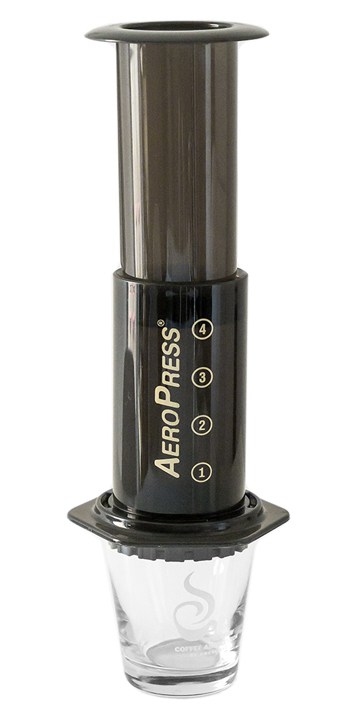 The Aeropress is a neat tool, it can do several things, one of these includes making fantastic espresso.
The Aeropress is a neat tool, it can do several things, one of these includes making fantastic espresso.
This is the average method for making espresso. However, it makes a double shot. If you only want a single shot of espresso, cut the water and coffee levels to about half.
- The first step is to heat up the water, outside the Aeropress, obviously. You’ll want to heat the water to around 85 degrees Celcius. The temperature can vary slightly, but this will get you the ideal result. You’ll also want to make more water than what’s called for, as it will equal out later.
- You’ll want about 39 grams of ground coffee. You can do this manually or buy it, but it will be much better if you grind it to a personal consistency. A burr grinder is the best way to grind coffee to a precise consistency. You can always go to the coffee shop and get them ground for you, although the coffee won’t be as fresh as if you ground it yourself.
- Set up the Aeropress and prepare it for brewing. You’ll want to place it in a sturdy container, as the pressure you’ll be putting on it is going to be quite high.
- Fill the Aeropress with the grounds and ensure they are compact.
- Now you just need to stir the coffee and steep it.
- About 30 seconds after stirring, you’ll want to steadily push with the weight of your hand on the plunge.
- Now you just need to serve.
It is important to note that coffee from the Aeropress won’t be as full as the coffee from an espresso machine if you use a paper filter. For this reason, I recommend using a metal filter for this, if at all possible, to get that much closer to espresso.
An Aeropress is a neat tool that is powerful and convenient to have if you make coffee often. While the Aeropress is an effective way to make an espresso, it is not quite on par with the moka pot. I’d take a look at the Aerobie Aeropress, if you want one of these.
Lastly, we will go over how to do this with a French press.
How to Make an Espresso With a French Press.
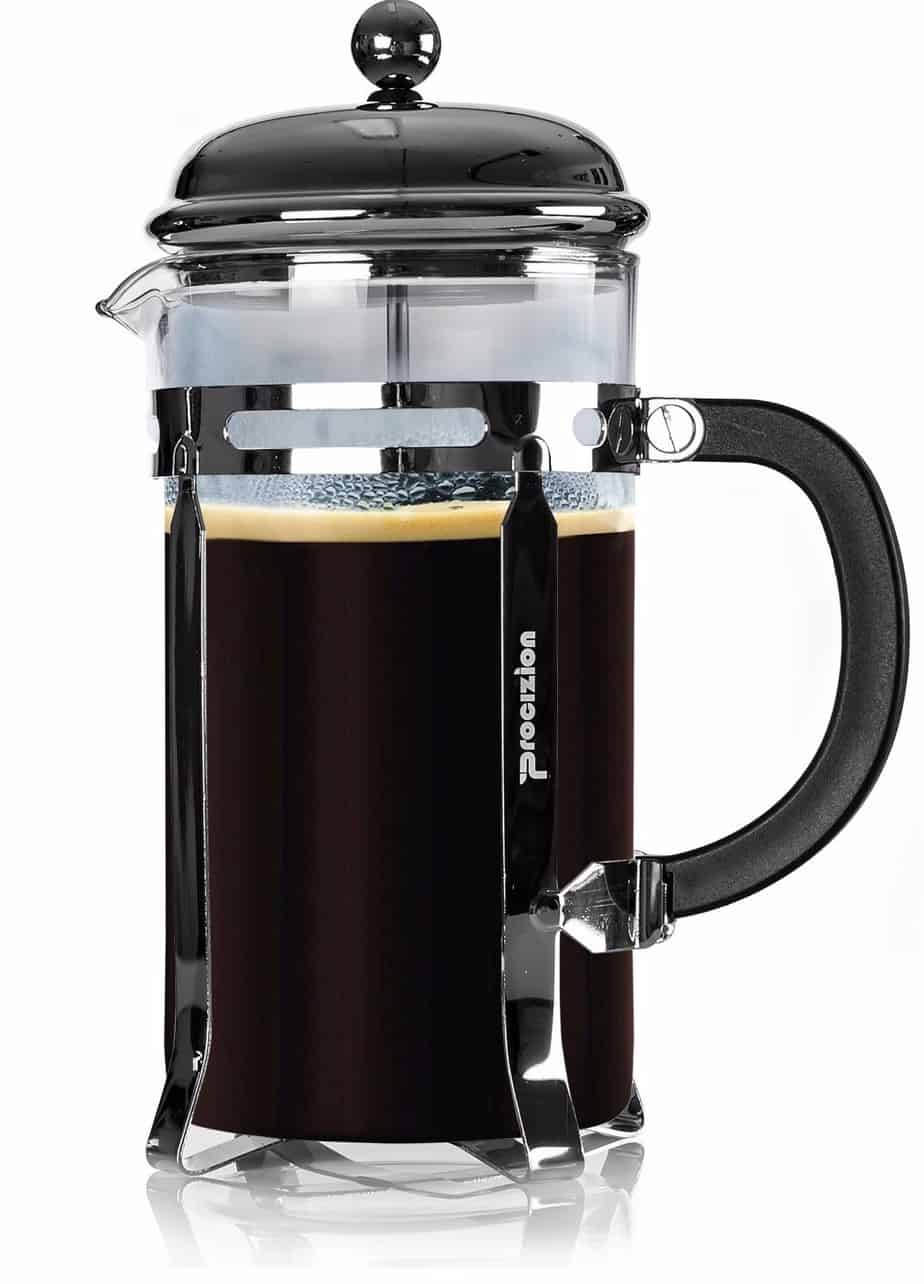 The French press is not the best of the three methods for making espresso. So we only really recommend it as a last resort, as you won’t get the same effect as you will from the other two methods, let alone an actual espresso machine.
The French press is not the best of the three methods for making espresso. So we only really recommend it as a last resort, as you won’t get the same effect as you will from the other two methods, let alone an actual espresso machine.
- Grind your coffee, as with all coffee you make in a French press, the grind needs to be as fine as possible to ensure the water goes through right.
- The water needs to be around 85-87 degrees C as with the Aeropress.
- Add the coffee grounds to the French press, use double the amount you would normally for a regular French press cup, this gets it closer to espresso.
- Add some more hot water to the French press, this will coax all of the oils out of the coffee. After a few moments, you will want to add the rest of your water and stir.
- Close the lid, but don’t plunge. Steep for about 4 minutes, depending on the strength of coffee you desire.
- Press the plunger down slowly and steadily. Go about halfway and then raise the plunger back up before you plunge the full length.
As I said, this method should only be a last resort for making espresso-like coffee. It is more of a strong-coffee rather than any sort of espresso, as there is only around 1-bar of pressure
If you are looking into obtaining a French press, take a look at the Cafe Du Chateu.
Which method would be best?
Overall, an Aeropress would be the best method for making espresso without a machine, with a French press being the worst. If nothing else, you can just go to a cafe.
While these methods won’t get you the exact same thing as an actual espresso machine will, you will get close enough to say it’s an espresso.
How To Make Espresso Without A Machine
 There are plenty of ways to make filter coffee without a machine designed specifically for the purpose. All you need is something to heat water and something to filter the beans from the water.
There are plenty of ways to make filter coffee without a machine designed specifically for the purpose. All you need is something to heat water and something to filter the beans from the water.
Espresso is a different animal, the machines to make them are not quite so simple, they are not just for convenience, they are necessary to achieve the brewing conditions that espresso by definition requires.
Espresso is made by forcing water through a puck of fine ground and compacted coffee, usually but not necessarily a dark roast variety. It is the pressure that’s the key, an espresso machine uses 8-10 bar of pressure to force the water through the grounds.
It is dangerous to consider firing scalding water at anything, anywhere, so making true espresso at home without a machine is not really possible or a sensible thing to even attempt.
So What’s The Next Best Thing?
Well, there are alternatives to espresso that are similar in taste that can be easily made without spending a lot of money on high tech machines. Here are the most common methods we advocate:
You Can Make Stovetop Espresso in a Moka Pot
 You can buy a really inexpensive stove top espresso maker, which uses heat to generate around 1.5 bars of pressure. This forces pressurized water/steam through fine espresso coffee grounds similar to standard steam pump espresso machines – the only difference is the amount of pressure used.
You can buy a really inexpensive stove top espresso maker, which uses heat to generate around 1.5 bars of pressure. This forces pressurized water/steam through fine espresso coffee grounds similar to standard steam pump espresso machines – the only difference is the amount of pressure used.
Here is our list of the the smallest stovetop espresso makers sold today. They are almost all very affordable and pretty small too.
You can also see this post to learn more about the differences between stovetop espresso and true espresso.
The beans used for a moka pot are the same kind and consistency as that of true espresso, and you can make a great drink this way once you get the hang of it. But the best part of all is that it keeps the art in the process.
The fancy machines which cost so much more money can take something of the romance out of coffee making, and while they are the best answer for those who like a quick, convenient and good cup of coffee, there’s a side of it that’s lost.
You Can Make and Espresso Like Drink With an Aeropress
 As I alluded to above good espresso machines cost a lot of money and they take a lot of dedicated space on your counter. There are smaller and cheaper espresso machines but most of them are hard to use and they just don’t perform well.
As I alluded to above good espresso machines cost a lot of money and they take a lot of dedicated space on your counter. There are smaller and cheaper espresso machines but most of them are hard to use and they just don’t perform well.
The espresso machines priced below $100 are usually affordable for most people but the qaulity of espresso you get will always be suspect… and around here we think that if you aren’t going to be making high quality espresso in your kitchen you might as well spend less money and get yourself a super cheap Aeropress which can be used to make a drink similar to espresso.
Most people love the quality of coffee made from an Aeropress and it has the added benefit of being super portable – people take these things camping for crying out loud!
An Aeropress also works a bit like a manual pump, pressing pressurized water through coffee grind and filter leaving you with a potent brew in your cup.
This is a lot like a moka pot but because you press coffee through a paper filter it ends up feeling cleaner (less fines) which many people appriciate.
We’ve got a full review of the Aeropress here for you to read or you can see this post comparing the Aeropress to stovetop espresso for more information.
Can You Make Espresso in a French Press
Now, I know what a lot of you are thinking – I don’t have an Aeropress but I do have a french press. Can I just make espresso with the french press instead?
Well, technically you can’t.
Although a french press brews by you pressurizing the coffee, the pressure generated is negligible and much less then you get while making stovetop moka, Aeropress coffee, or true espresso.
For people who have a really good french press the best way to replicate something similar to espresso is to use a finer grind than you normally would and brew your coffee for a shorter amount of time.
Instead of brewing coarse grind in a French press for 4 minutes maybe you could experiment with brewing a medium-fine grind for two minutes and then pressing just the same as you would have otherwise.
The fine grounds will press into the mesh strainer causing a good deal of solids to pass through but many of the gaps in the strainer will nearly clog giving you extra pressure in your extraction.
It’s worth keeping in mind though that this is probably the worst version of espresso on this list. Your coffee will be a weirdly brewed french press coffee and will be full of grit. Be prepared to not drink the last of your cup and press pot and do not expect to get the potency of espresso or any crema at all.
You Can Also Make Espresso on a Stove in a Pan (Kinda)
I should rephrase this claim before you really think this is espresso. With this method you will be making something similar to Turkish coffee rather than espresso. Turkish coffee is similar to espresso in strength and potency but it is different and it is actually pretty similar to making cowboy coffee on a campsite somewhere.
With Turkish coffee you would traditionally use a special turkish coffee pot but the vast majority of people don’t own these.
In it’s place you will just take the smallest sauce pan you have and put it on the stove filled with simmering water and ultra fine coffee grind.
Most grinders will make a decent espresso grind but we recommend some of the mid range Baratza coffee grinders to give you quality grind consistency from coarse grind all the way to the ultra fine Turkish grind size.
As you prepare your coffee you need to keep in mind that the goal is to make a potent batch of coffee and not pressurized espresso with crema. Properly brewed Turkish coffee will give you portion sizes and strength that espresso drinkers or mixed espresso drinks require. They will have more body than true espresso though so like a french press stay away from the last bit of coffee as it will be packed with solids.
Just Because It’s Not Espresso Doesn’t Mean It’s Inferior
Anyone wanting to learn the art of making coffee could appreciate the control offered by the stovetop coffee makers, they allow for a world of variables and experimentation, the result of this practice is the perfection: a coffee that suits you personally that only you know how to make. It’s a skill isn’t just about pressing some buttons and leaving the magic to the engineers.
While operating an espresso machine is certainly a skill in itself, if you’re the sort of person who wants to learn about making coffee the best way to do this is to limit the work of the equipment you’re using and do as much of it yourself as you can. With care and attention you really can match the top machines with a cheap and simple metal pot, lots of passion and persistence.
History and Rise of the Espresso
Angelo Moriondo, an Italian engineer, came up with the brilliant idea of a steam-driven instant coffee machine in Turin back in 1884. Improvements to the initial machine were made by Luigi Bezzera of Milan seventeen years later. These two inventors developed their machines on a design similar to the automatic drip coffee maker of today.
The difference though is that the amount of pressure forced upon the coffee grind is much higher. In other words, the water pushes down upon the beans very fast, like the showerhead of an automatic drip coffee machine on steroids. This explains the idea of Moriondo, the faster the water is forced unto the beans, the faster the process becomes which makes it “instant”. This is also how the name of the coffee came about. Espresso is Italian for “expressly” or fast.
The Espresso crave eventually spread throughout Italy with the cultivation of “espresso bars” or coffeehouses. These came about since the Espresso was something new and fresh and since those machines were expensive, only commercial establishments had the capital to serve them. As with Italy, the satisfaction of enjoying Espresso and the social interaction that went along with it caught on with the rest of Europe.
Espressos are now among the most famous types of coffee out there. This is particularly due to a well-known coffee establishment which began in Seattle popularizing the beverage. Before that though, Espressos already had a strong following in Europe, especially in Italy where one would find Espresso bars in just about every corner.
Needless to say, the Espresso started to take over the world by storm after sales picked up in the United States in the 80s. The demand for this coffee was so great people wanted to have the convenience of being able to make one in the comforts of their own home.
Thus, the Espresso machine started selling out like hotcakes. This only served to further the popularity of the Espresso. Unfortunately, the convenience brought upon by Espresso machines has put Espresso fanatics all over the world in a hard place. What if you, dear Espresso lover, find yourself in a place without one?
The goal of this article then is to enumerate ways in which you can still make Espresso without having an automatic Espresso machine. But before that, let us discuss the history of the Espresso and what makes it a must-drink beverage in the first place.
Espresso Brewing Explained
Unlike other types of coffee, Espressos are brewed with the use of very hot water and forced into the coffee intense pressure. In other words, the Espresso brewing process is a combination of percolation and Automatic Drip albeit at a very fast rate. The super-hot water is created through the use of pressure (a topic discussed greatly in our pressure cooker articles). This water is then forced through the beans as one would in an Automatic Drip Coffee machine but in Espressos, the amount of force is much more powerful, as in 132 pounds per square inch powerful.
The resulting beverage is thick and creamier than other types of coffee, its signature look. It also has a stronger taste. These two characteristics are the result of the high pressure brewing process and a greater presence of caffeine in Espressos compared to other types of coffee.
Espressos require a fine grind of coffee, as fine as the texture of confectionary sugar. Master barista Giorgio Milos says that the perfect espresso has seven to eight grams of freshly ground roasted coffee which has been roasted two to three days in advance and is preserved using pressurization. Furthermore, the water used in the brewing process should be no less than 190 degrees Fahrenheit and no more than 200 degrees Fahrenheit with a pressure of 9 bar of force. Ideal extraction time is from 25 to 30 seconds.
It’s very important here to use fresh ground coffee, not pre-ground! You will notice a difference in taste otherwise.
The fine ground beans are placed in what is called a portafilter, a cylinder about 2 inches in height with a filter in the bottom and a handle. The bottom of the portafilter is attached to what looks like a faucet from which the espresso comes out.
It is also recommended that one drink an Espresso as quickly as possible. Also known as “Espresso shots”, drinking an Espresso quickly is a means to enjoy the full flavor an Espresso offers. The crema, the emulsion of the coffee’s oils, that forms on top of the Espresso keeps the aromas of the coffee in. You shouldn’t wait for the crema to dissipate because when this happens, the aromas and the flavor of the coffee vanish with it.
Making Espresso Without an Espresso Machine
The Espresso machine is thus made crucial because of its ability to do two things. Firstly, it is able to generate super-heated water and secondly, it is able to push as much force of water through the coffee beans.
The closest coffee appliance that resembles the Espresso machine is the Moka pot which we have discussed in a previous article. Basically, the Moka pot, like the espresso machine is able to generate super-hot water as well as apply some amount of pressure into the coffee beans.
Like the Espresso, Moka pot brewing also uses a fine grind to make the permeation process much easier and faster. Also, the coffee yielded by the Moka pot is thick and creamy, but not on par with the Espresso.
Unfortunately, as mentioned in the conclusion of our Moka pot vs. French Press article, Moka pots are unable to truly emulate the taste of an Espresso. This is mainly because the force generated by the Moka pot is nowhere near the force generated by the Espresso machine.
This gives the Moka pot brews a distinct flavor which is unlike the traditional drip brews nor the Espresso.

